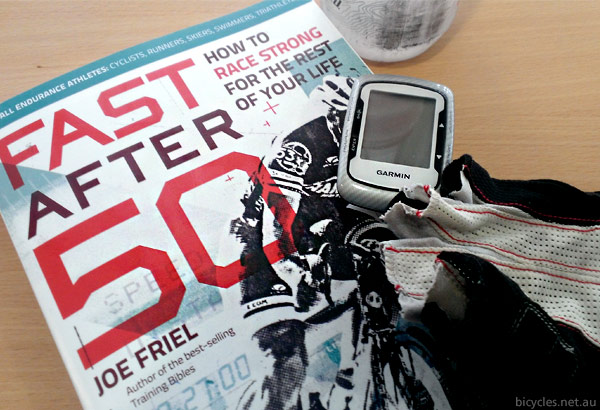Yes, I am over 50, but I only got serious about cycling about 4 years ago. I did have an active background in rugby league, rugby union, tennis, and sailing, but I did not reach the dizzy heights of a spectacular sporting success – I just kept plodding. According to endurance sports coach Joe Friel and the extensive evidence he presents in his new book Fit After 50, now that I’m “After 50” I will have reduced aerobic capacity, increased levels of body fat, and reduced muscle mass. Please Joe, is there good news? Yes, there is!
Right from the outset I must declare that I’m a born sceptic. Whenever I see the words “proof” or “proven” I usually utter the words “Okay prove it – but you better have pretty good evidence.” I was quietly surprised that most claims from this book appear to be backed up by substantial evidence. There is an impressive twenty pages of references in this 328 page book; Friel lays his cards on the table for all of the book’s content.
Friel begins by establishing the health benefits of maintaining physical activity as we move past the age of 50. He also highlights the nurture side of the equation; Friel recognises that any efforts “start in the head”. Many people I’ve spoken to who started late in cycling say the same thing – it’s mainly the organ between the ears that’s the biggest barrier. Yes, our bodies have accumulated physical “souvenirs” of our (mis)adventures, and the memories of our exertions will inform our future attempts, but Joe does give you hope and is able to prove why a well thought out training program can keep you “Fast After 50” and can slow the ageing process.

While training over the past few year, I was always worried that I had a short attention span since I was bored on long-long training rides. Friel’s book uses quite a bit of anecdotal wisdom from past and current older athletes and I was presented with a World champion cyclist who used shorter rides than his competitors to achieve his triumphs. I had heard of high intensity training/lower volume training, but hadn’t had a lot of experience in it. HIIT or High Intensity Interval Training is mentioned regularly in a lot of exercise physiology literature and Friel leads the reader through the process of incorporating the principles of HIIT into their training with good use of insets and tables.
Friel always writes in terms of athletes, not cyclists, and the principles espoused are easily adapted to all athletic disciplines. As I am not a runner/jogger/walker, and injury precludes me from taking part, I am unable to comment on the benefit of the book in these areas. Regardless, Joe captures a wholistic picture of the aging athlete and his explanations are well articulated and not overly complicated. The coverage of the ageing process is disturbing, but the direction he gives you is affirming.

“Okay Joe,” I thought to myself, “I’m convinced. I’ll give some of your workouts a try”. The High-Dose Aerobic Capacity 5 x 2.5min and 5 x 3min workout sounded achievable; I’ve been riding for a while, building well, and wanted to see how it went. I used Trainer Road to create the workouts and set to on my trainer. The first 3 intervals were hard but manageable. I kept looking at the next 8 intervals yet to come and grimaced. I wasn’t feeling too crash hot after 5 intervals, so I stopped. I didn’t think it would be that bad! I checked the book and had a bit of a read – oops, the two sets of intervals were actually two workouts. Message to self – don’t skim read!

As I worked through the book, I kept getting the feeling that this book may be better suited to the life-long athlete who has built a life time of habit. Friel points out the importance of having a regular routine of exercise earlier in life and how this is important as it is likely to sustain the memory of hard work in achieving success. He continually addresses the reader as an athlete – I don’t consider myself to be an athlete. There is a difference between being active and a life-long athlete. Do not let this hold you back from learning from Joe’s decades of experience and continuing research, however.
I have considered, many times, quitting the routine of getting up at 4.30am five times a week and riding, and just letting myself go; let’s face it, it’s easier to do that. Too old, too cold, not enough sleep, too fat, too slow – yep, that’s me. I have kept going by picking up new motivations along the way. Recently I was considering leaving the sport.
Things like Joe Friel’s book have made think deeper about the way I approach my riding. Good riders talk about kilometers ridden per week; long kms are good training, as long as that’s what you’re training for. Quality kms are extremely important, and I like the HIIT approach in this book, so I’m motivated to try to do both at the moment as I have mixed targets. Maybe I can still be Fast After 50. Let’s face it I was never really fast before 50. Wish me luck.
Details
Title: Fast After 50: How to Race Strong for the Rest of Your Life
Author: Joe Friel
Format: Paperback with illustrations, 7″ x 9″, 336 pp.,
Retail Price: $21.95 (USD)
E-Book available from Velopress
ISBN: 9781937715267

